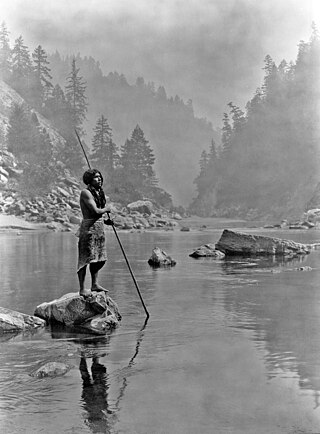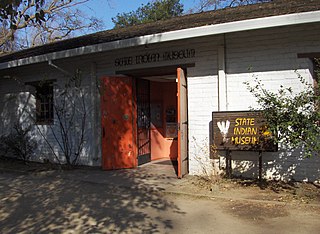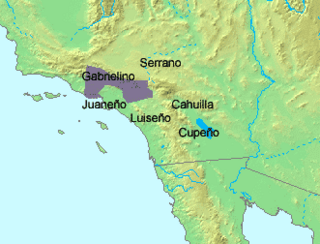
The Tongva are an Indigenous people of California from the Los Angeles Basin and the Southern Channel Islands, an area covering approximately 4,000 square miles (10,000 km2). In the precolonial era, the people lived in as many as 100 villages and primarily identified by their village rather than by a pan-tribal name. During colonization, the Spanish referred to these people as Gabrieleño and Fernandeño, names derived from the Spanish missions built on their land: Mission San Gabriel Arcángel and Mission San Fernando Rey de España. Tongva is the most widely circulated endonym among the people, used by Narcisa Higuera in 1905 to refer to inhabitants in the vicinity of Mission San Gabriel. Some people who identify as direct lineal descendants of the people advocate the use of their ancestral name Kizh as an endonym.

The Esselen are a Native American people belonging to a linguistic group in the hypothetical Hokan language family, who are Indigenous to the Santa Lucia Mountains of a region south of the Big Sur River in California. Prior to Spanish colonization, they lived seasonally on the coast and inland, surviving off the plentiful seafood during the summer and acorns and wildlife during the rest of the year.

The Maidu are a Native American people of northern California. They reside in the central Sierra Nevada, in the watershed area of the Feather and American Rivers and in Humbug Valley. In Maiduan languages, maidu means "man".

The Hupa are a Native American people of the Athabaskan-speaking ethnolinguistic group in northwestern California. Their endonym is dining’xine:wh for Hupa-language speakers in general, and na:tinixwe for residents of Hoopa Valley, also spelled Natinook-wa, meaning "People of the Place Where the Trails Return". The Karuk name for them is Kishákeevar / Kishakeevra. The majority of the tribe is enrolled in the federally recognized Hoopa Valley Tribe.

The California State Indian Museum is a museum in the state park system of California, United States, interpreting the diverse cultures of the Indigenous peoples of California. It is located in Midtown Sacramento at 2618 K Street. The museum exhibits traditional items illustrating the varying cultures of the state's first inhabitants. The Native population of California, one of the largest and most diverse in the Western hemisphere, was made up of over 150 distinct tribal groups who spoke at least 64 different languages. Prior to the arrival of the first European explorers, the native population is estimated to have been in excess of 500,000 people.

The Yokuts are an ethnic group of Native Americans native to central California. Before European contact, the Yokuts consisted of up to 60 tribes speaking several related languages. Yokuts is both plural and singular; Yokut, while common, is erroneous. 'Yokut' should only be used when referring specifically to the Tachi Yokut Tribe of Lemoore. Some of their descendants prefer to refer to themselves by their respective tribal names; they reject the term Yokuts, saying that it is an exonym invented by English-speaking settlers and historians. Conventional sub-groupings include the Foothill Yokuts, Northern Valley Yokuts, and Southern Valley Yokuts.

Indigenous cuisine of the Americas includes all cuisines and food practices of the Indigenous peoples of the Americas. Contemporary Native peoples retain a varied culture of traditional foods, along with the addition of some post-contact foods that have become customary and even iconic of present-day Indigenous American social gatherings. Foods like cornbread, turkey, cranberry, blueberry, hominy, and mush have been adopted into the cuisine of the broader United States population from Native American cultures.

The Tongva language is an extinct Uto-Aztecan language formerly spoken by the Tongva, a Native American people who have lived in and around modern day Los Angeles for centuries. It has not been a language of everyday conversation since the 1940s. The Gabrielino people now speak English but a few are attempting to revive their language by using it in everyday conversation and ceremonial contexts. Presently, Gabrielino is also being used in language revitalization classes and in some public discussion regarding religious and environmental issues. Tongva is closely related to Serrano. The names of several cities and neighborhoods in Southern California are of Tongva origin, and include Pacoima, Tujunga, Topanga, Azusa, Cahuenga in Cahuenga Pass and Cucamonga in Rancho Cucamonga.
The Kitanemuk are an Indigenous people of California and were a tribal village of the Kawaiisu Nation.The Kawaiisu traditionally lived in the Tehachapi Mountains and the Antelope Valley area of the western Mojave Desert of southern California, United States which has historically has been within the territory of the Kawaiisu. Today some of these members people are enrolled in the federally recognized Tejon Indian Tribe of California.

The Tübatulabal are an indigenous people of Kern River Valley in the Sierra Nevada range of California. They may have been the first people to make this area their permanent home. Today many of them are enrolled in the Tule River Indian Tribe. They are descendants of the people of the Uto-Aztecan language group, separating from Shoshone people about 3000 years ago.

The Nisenan are a group of Native Americans and an Indigenous people of California from the Yuba River and American River watersheds in Northern California and the California Central Valley. According to a 1929 archeology and ethnology press release by University of California, Berkeley, the Nisenan people are classified as part of the larger group of Native Americans known as the Maidu, though some dispute the accuracy of this relationship, including the Nisesan themselves. According to the Nisenan website, the United States' claim that they are Maidu is a misclassification and is inaccurate. As the Nisenan put it,
"Like many other Tribes throughout the United States, the Nisenan have been misidentified and mislabeled. The Nisenan have been lumped together under inaccurate labels such as "Maidu", "digger" and "southern Maidu". However, the Nisenan are a separate Tribe with their own Cultural lifeways, their own leaders and holy people, a distinct geographic territory and their own ancient and unique language."

The Tongva Sacred Springs are a group of springs located on the campus of University High School in Los Angeles, California. The springs, called Koruuvanga by the native Gabrieleno Tongva people, were used as a source of natural fresh water by the Tongva people since at least the 5th century BC and continue to produce 22,000–25,000 US gallons (83,000–95,000 L) of water a day. The springs are also sometimes referred to as the Gabrieleno-Tongva Springs, the Tongva Holy Springs, and the Sacred Springs.

The Cold Springs Rancheria of Mono Indians of California is a federally recognized tribe of Mono Native Americans. Cold Springs Rancheria is the tribe's reservation, which is located in Fresno County, California. As of the 2010 Census the population was 184.

The Tule River Indian Tribe of the Tule River Reservation is a federally recognized tribe of Native Americans. The Tule River Reservation is located in Tulare County, California. The reservation was made up of Yokuts, about 200 Yowlumne, Wukchumnis, and Western Mono and Tübatulabal. Tribal enrollment today is approximately 1,857 with 1,033 living on the Reservation.

Indigenous peoples of California, commonly known as Indigenous Californians or Native Californians, are a diverse group of nations and peoples that are indigenous to the geographic area within the current boundaries of California before and after European colonization. There are currently 109 federally recognized tribes in the state and over forty self-identified tribes or tribal bands that have applied for federal recognition. California has the second-largest Native American population in the United States.

A clapper stick is a traditional idiophone common among the indigenous peoples of California. It is traditionally constructed by cutting the branch of an elderberry tree, hollowing it out, and partially splitting the branch in two. It is used to keep time and accompany singers and dancers. Many are now made of bamboo, which do not require hollowing.
Kizh, or Kit’c, are the historically and ethnographically documented lineal descendants of the Mission Indians of San Gabriel, an Indigenous peoples of California. They belong to a group commonly known by the Spanish name, Gabrieleño.

Linda Yamane is an Rumsien Ohlone artist and historian, and has reconstructed and "almost singlehandedly revived" the Rumsien language, Rumsien basket-making methods, and other Rumsien traditions.

Vivien Risling Hailstone was a Yurok/Karok basketweaver, jewelry designer, activist and educator who led efforts to sustain traditional basket weaving patterns and techniques. Hailstone also had an impact on statewide policy for repatriation of Native American remains and returning to Native American names for parks through her involvement with the State of California Department of Parks and Recreation Commission.

Tovaangar refers to the Tongva world or homelands. It includes the greater area of the Los Angeles Basin, including the San Gabriel Valley, San Fernando Valley, northern Orange County, parts of San Bernardino County and Riverside County, and the southern Channel Islands, including San Nicholas, Santa Catalina, Santa Barbara, and San Clemente. The homelands of the Chumash are to the northwest, the Tataviam to the north, the Serrano and Cahuilla to the east, and the Acjachemen and Payómkawichum to the south.


















